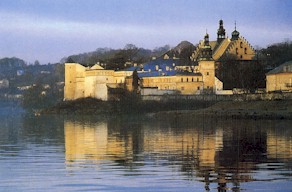| This is a closeup view of the main entryway
into the Abbey of Krakow. |
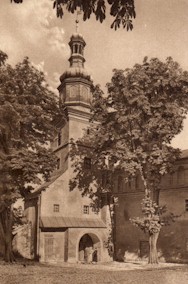
|
|
The medieval parts of the walls are
preserved up to the cornice moulding. In the western fragment of the
northern elevation, we can notice part of the late Romanesque masonry from
13th century, with an arched moulding from shaped brick on the
first floor. In the northern wall there are two partially mured windows.
In the western bay of the northern wall there is a Romanesque portal made
of sandstone, which dates back to the 13th century. It is now
covered by the vestibule. Only a few fragments have been preserved. The
door is flanked by posts with cubic capitals, on which there is an arch of
an archivolt with a square cross-section. The set-off portal is protruding
from the wall. The semicircular archivolt, which rests on columns (two at
each side) with flower bud capitals connected by a common abacus, is
profiled accurately to the number of supports. The lower parts with attic
bases of the columns are hidden underneath the floor of the vestibule.
The church was rebuilt at the beginning of the 17th century.
|
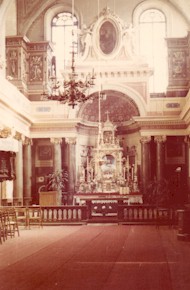
|
| The building is a
part of a large walled complex of monastic constructions with east-west
orientation, which were erected around two courts. The northern wing
situated by the first is from the second half of the 13th
century and housed the chapter-house, probably the refectory, and the
dormitory. In the cellar, we discover a portion of unidentified square
stone masonry from the turn of the 12th century. The remaining
buildings, which were wooden until the end of the 15th century,
were consumed by the fires in 1494 and 1527.
|
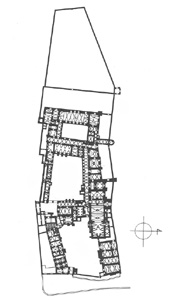 |
| Crucifix: end of the
14th century, polychrome wood, height c. 130cm, now in the
cloister chapel. The arms of
Christ are slightly diagonal in relation to the horizontal beam of the
cross. The head of Christ is leaning to the right and His eyes are closed.
He has a short beard and long, shoulder-length hair. The anatomical
details are scrupulously produced. There are spurts of blood running down
from His wounds. Short perisonium formed by a draped stripe of cloth is
crossed at the front. One of its ends forms a bundle of vertical foldings
with scattered tips on the left. His body is ivory, His hair and beard are
brown and the perisonium is golden.
|
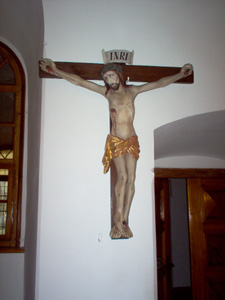 |
| Crucifix: c. 1500,
polychrome wood, height c. 170 cm, presently in the vestibule of the
convent church under the northern tower.
The arms of Christ are horizontal. His head is leaning to the right
and His eyes are closed. He has a beard and long, shoulder-length hair.
The anatomical details such as tense muscles of his arms, the structure of
the ribs and a sunken stomach are scrupulously produced. There are spurts
of blood running down from His wounds. A densely draped stripe of cloth
forms a short perisonium tied at the front. One of its ends is drawn
inside between the thighs. Its right end is scattered. His body is ivory
covered in bloody stains, His hair and beard are brown and the perisonium
is white.
|
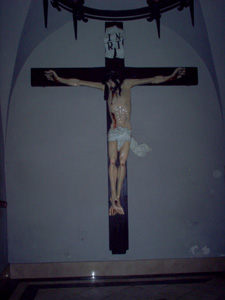 |
| Statue of The
Resurrected Christ: c. 1380, height 100 cm, polychrome wood, now in
the cloister. A statue of a
standing Christ with shortened stubby body proportions, he has a big head
which is slightly leaning to the right. His hair is long with a part and
His short beard is divided in the middle. His neck is bulky and His feet
are enlarged. His right arm is bent at the elbow and held up in the act of
blessing. In the left hand, which is slightly stretched forward, there is
a cross (which was added later). His shoulders are covered with a cloak,
which reaches the ground at the back. The draped flap of the cloak which
slings from His right forearm, flows from left to right covering his body
from the waist to the knees. His torso and shanks are naked. His cloak is
red with a blue lining and a golden trimming. His body is ivory and His
hair and beard are brown. There are bleeding wounds on his hands and feet
and and the lance wound on his right side.
|
 |
| Panel painting
represented The Virgin with the Child: beginning of 16th
century, temper on wood, c. 90 x 70 cm, now in the nun’s choir.
A semi-statue of Mary slightly turned to the right wearing dark
blue cloak dotted with golden stars with a crimson lining and thick golden
trim. In her right hand, she is holding an apple. Her eyes are turned to
the left. On her left forearm, there is a Baby Jesus clad in a cinnabar
dress with gold trim. His blond head is turned towards Mary. His right arm
is held in the act of blessing and the left one supports a closed red book
resting oh his lap. Behind the heads of the figures, there are golden
nimbuses. The background is golden stamped with stylised acanthus leaves.
|
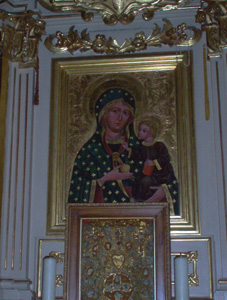 |
|
Gradual: 1527,
perg., lat., pp. 116, 47,5x35,5, Cloister’s Library and Archive in Kraków
(510). Foundation of the
abbess Anna Grabowska. Written down by brother Victorin, a Dominican from
Krakow
. On the card 1v colophon in Polish: Thy kszągy albo then mszał
sp [...] yla panna Anna Grabowska panu Bogu na czescz i na chwałę
y yego namyleysey matuchnye pannye Marieyey y Szwyathemu Augustynowi y
myley S. Annie Samothrzeczey [...] y ja tesz grzey kaplan brath Victoryn s
Krakowa od szwaythey Trójcze zakonu kasnodzeysyego, którim thy kszęgy
pyssal.
Eight figural
initials made by author of the illuminations in Collectarium from
the Wawel Cathedral in
Krakow
:
16r - A – St.
Gregory the Great
91v – P – The
Nativity
98r - N –
The Resurrected Christ
147r - T – View
of the Norbertine nuns’ church(?)
30r - D –
St.
John the Baptist
43v – G – The
Virgin with the Child adored by brother Wiktoryn and abbess Anna Grabowska
165r – C –
St. Anne and the Virgin with the Child adored by abbess Anna Grabowska
45v – I – St.
John Evangelist and St. Augustinus adored by brother Wiktoryn and abbess
Anna Grabowska
Numerous
pictorial leafy initials, with tendrils protruding onto the margins.
|
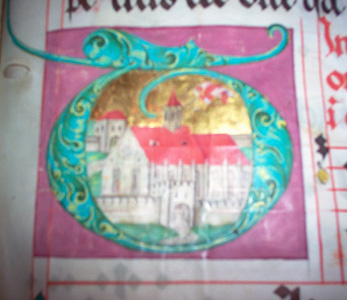 |
|
Antiphonarium:
first half of the 16th century, perg., lat., pp. 254,
Cloister’s Library and Archive in
Krakow
(510).
Four figural
initials:
19r – E – The
Annunciation
57r – The
Nativity
185v – The
Resurrected Christ
229v – S –
Christ as a Man of Sorrows
Numerous
pictorial initials with tendrils protruding onto the margins.
|
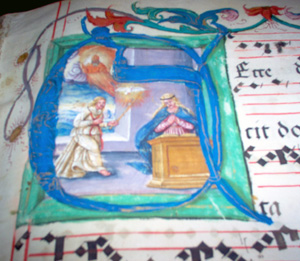 |
| |
|
| |
|
| |
|
| |
|
| |
|
| |
|
| |
|
| |
|
| |
|
| |
|
| |
|
